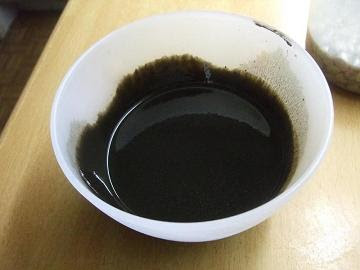| Arroz negro con allioli (black rice with garlic mayonnaise) is now a classical dish across Spain, including Catalunya. And it was while undertaking a brief training stage in Catalunya at the Hotel Mas Passamaner in Tarragona that I first came across it. Head Chef at the hotel's La Gigantea restaurant, the multi-Michelin-starred Joaquim Koerper, originated the technique in the early 1980s, using squid ink. In this recipe, I use octopus ink instead. Ingredients (serves 2) 200ml octopus ink 2 Spanish onions 4 cloves garlic 150g short-grain rice 4 tbsp allioli olive oil garlic & guindilla oil (or 1 clove garlic and 1 guindilla chilli) salt black pepper Method |
 | I'm not expecting you to prepare your own ink, as I did. Nor would I for a home meal under normal circumstances, but I'd been preparing octopus ink at work in the kitchens of Lasarte and was able to take some perks home with me. The strange, pearl-like globules you can see in the photo are the individual ink sacks of hundreds of baby octopi ("pulpitos" in Spanish), painstakingly squeezed from the heads of these miniature cephalopods by yours truly. |
| You can purchase octopus ink from specialist stores and on-line suppliers, although you may find it easier to obtain squid ink, which will do just as well. In the bowl on the right is my raw ink, ready for cooking. I obtained this by blitzing up the ink sacks with an immersion blender and passing the resulting jet-black mess through a fine sieve. |  |
 | In order to make a home-cooked arroz negro from scratch, you begin by making a stock with the ink, as a base in which to cook the short-grain rice. Begin by sautéeing off some roughly chopped Spanish onions in olive oil, with a little added garlic & guindilla oil. If you can't source the ready-made oil, just crush and finely chop the garlic and guindilla chilli and add them at this stage. Cook the onions gently until they are translucent and have softened up considerably. |
| Then smash up the cloves of garlic and throw them into the pot to perfume the onions and add some extra depth of flavour. Leave the onions to sautée together with the garlic for quite a while, allowing natural caramelisation to occur slowly and a gentle sweetness to be achieved in the finished product. |  |
 | At this stage, pour in the octopus ink to deglaze the pan and cook very slowly for half an hour or so. The photo on the left shows the resulting stock in all its filthy, murky glory. |
| Now you have your magic, salty, black dye all that is left to do is to cook your white short-grain rice in it. |  |
 | After a while, you will find that the ink has reduced down to a dry, glutinous sauce that binds the grains of rice together much like a risotto. |
| Finally, no arroz negro would be complete without a big fat dollop of spicy allioli to ripple through the melting heat of the rice. Here's a dish that could just as easily be adapted to a Michelin starred restaurant's menu as it could be served in hefty portions at a hearty banquet for the local villagers. Either way - whether presented as fine dining or rustic fare - this is real Catalan soul food. |
 |



